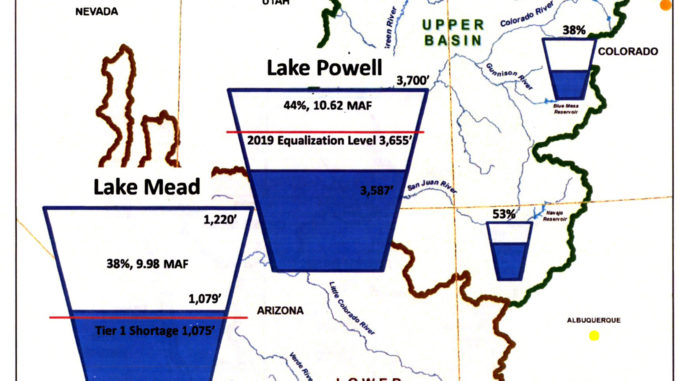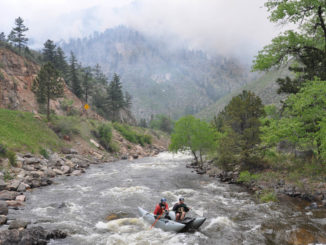
By R. Gary Raham
On November 14, 2018, The Northern Colorado Water Conservancy District hosted a forum focusing on the Colorado River—that enormous artery of water that sustains in excess of 30 million people in seven states. The afternoon’s event featured a panel of experts whose knowledge and actions will help determine the health and wealth of all of us in the American West. As one-time Colorado poet laureate, Thomas Hornsby Ferril, once wrote, “Here is the land where life is written in water.”
The panelists included:
Brad Wind, General Manager, Northern Water, who moderated the forum.
Kyle Whitaker, Colorado River Program Manager, Northern Water
Bennett Raley, Legal Counsel, Trout Raley P.C.
James Eklund, Colorado Commissioner to the Upper Colorado River Commission
Karen Kwon, First Assistant Attorney General to the Federal Interstate Water Unit
Andy Mueller, General Manager, Colorado River District
Kwon spoke first and spoke quickly. She outlined Colorado River Water laws. The oldest and most important of which is The Colorado River Compact of 1922. Then Secretary of Commerce, Herbert Hoover, suggested that the Colorado River Basin be divided into Upper and Lower Basins, each one in control of 7.5 maf or “million-acre-feet” of water. (One acre-foot of water equals 325,851 gallons of water—enough to serve 3,258 people for one day.)
Whitaker spoke second, and addressed river hydrology: Where is the water, how much is there now, and—with as much crystal ball power as you can summon—in the future? Hoover formulated the all-important Colorado River Compact during a time of water largesse. Since then, water average flows have dropped, culminating with a record low in 2002 that left bathtub rings of calcium carbonate around Lake Powell, the big pot of water that stores water for the Upper Basin states of Colorado, Wyoming, Utah, and New Mexico. Are the declining averages we see today just an extended drought or a new normal?
Eklund spoke about drought contingency plans or DCPs. The map of the upper and lower river basins shows where water is stored in reservoirs and their levels. Lake Mead is the “big bucket” for the lower basin. Because of water law agreements, if it dips below the Tier 1 storage level, it could cost nearly 3 maf of water allocation from the north. Conservation measures in member states have so far avoided that problem, but successive years of low water would make that increasingly more difficult.
The Upper Basin harbors the sources that feed the mighty river, so managers there have more options but, as Raley points out, they need to pay attention to what the Lower Basin does in terms of creating DCPs. Many aspects of river law are complicated and require Federal legislation. The United States must also insure that Mexico receives 1.5 maf as guaranteed by the Mexican Water Treaty of 1944.
Mueller, who lives on the western slope of Colorado, emphasized that Coloradans on both side of the Continental Divide are co-dependent economically—even though the west slope populations have traditionally complained when much of their water got diverted through tunnels to the east. Eighty percent of Colorado River water flows on the western slope, but eighty percent of Colorado’s population lives on the eastern slope. “We must make the right decisions about water in the next ten to fifteen years to avoid economic chaos,” Mueller said. That chaos would result from draconian measures that might have to happen to prevent the big reservoirs from becoming so low that they could no longer move the turbines that create electricity for their many customers. A 2002-style drought year, when reservoirs are already considerably below capacity, could do that.
Two items of good news: 1. Snow pack levels are high so far this year in the Upper Basin. 2. Colorado water watchdogs on both sides of the divide are talking with each other to help solve water problems. Real communication is crucial.
Engineers tend to look toward engineering solutions to solve hydrology problems, like building more water buckets in the form of reservoirs. Conservationists contend that conserving water and leasing water rights from agriculture can do the job of supplying water to a growing population without destroying river flow and the environmental services that flow provides.
Citizens, in the end, must take responsibility for making sure our water watchdogs make the right choices. Their lives depend on it.
Support Northern Colorado Journalism
Show your support for North Forty News by helping us produce more content. It's a kind and simple gesture that will help us continue to bring more content to you.
BONUS - Donors get a link in their receipt to sign up for our once-per-week instant text messaging alert. Get your e-copy of North Forty News the moment it is released!
Click to Donate
